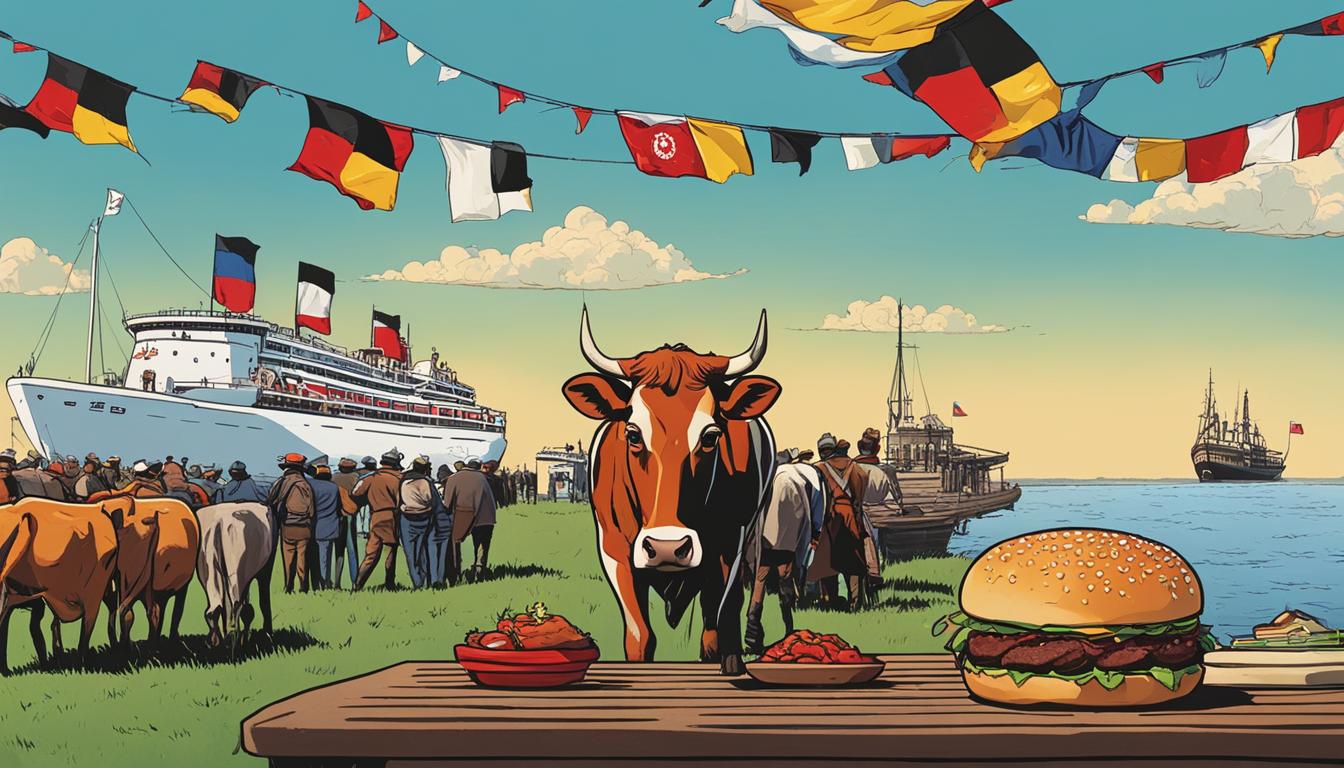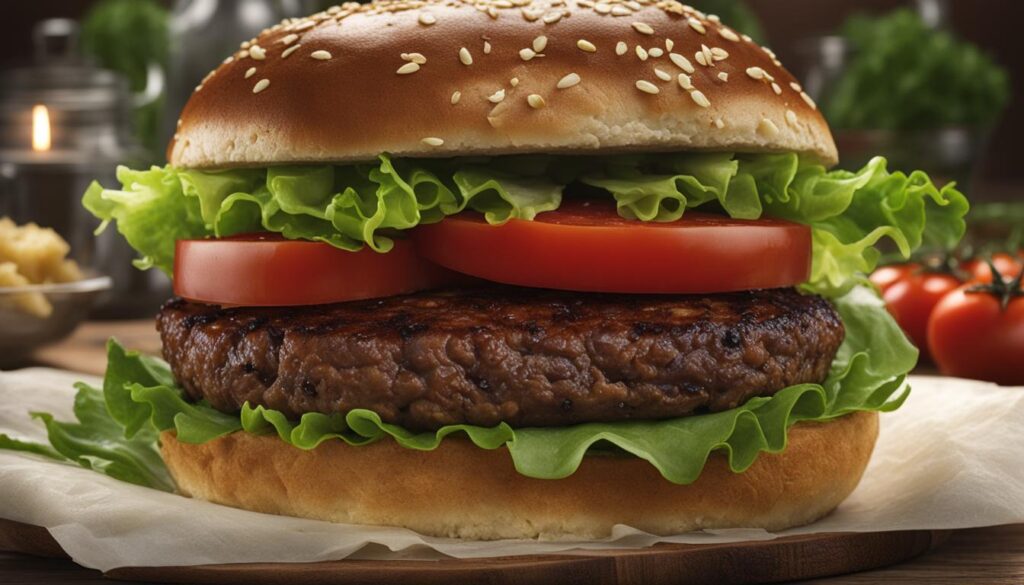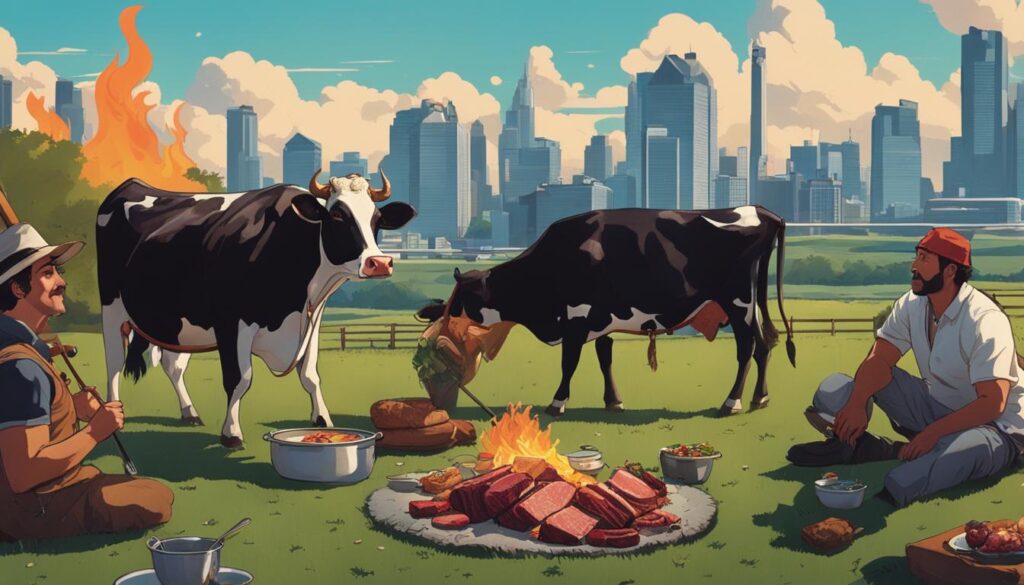Unraveling the Mystery: Why is Hamburger Called Hamburger?
Have you ever wondered why we call that delicious meat patty sandwiched between a bun a “hamburger”? It’s a question that has intrigued food enthusiasts and historians alike. Join me as we dive into the origins and etymology of this beloved American classic.
Key Takeaways:
- The term “hamburger” originated from Hamburg, Germany, where a dish called Hamburg steak was popular.
- Hamburg steak was brought to the United States by European immigrants, eventually evolving into the modern hamburger.
- The term “hamburger” first appeared on a menu in 1873 at Delmonico’s restaurant in New York City.
- Competing claims exist about who first put a patty between two slices of bread, with Frank and Charles Menches, Charlie Nagreen, and Oscar Weber Bilby all being credited.
- Despite its name, hamburgers don’t actually contain any ham and have become an enduring symbol of American cuisine and fast food culture.
A Culinary Journey from Hamburg to America
To fully understand the origins of the name, we must travel back in time to the bustling streets of Hamburg, Germany. It is here that the roots of the modern hamburger can be traced. In the early 19th century, a dish known as Hamburg steak was popular among the working class in Hamburg. The dish consisted of a fried patty made from minced beef, chopped onions, eggs, bread crumbs, and spices.
As Europeans began to immigrate to the United States in the mid-1800s, they brought with them their culinary traditions, including the Hamburg steak. However, it wasn’t until later that the concept of placing the patty between two slices of bread emerged. The term “hamburger” first appeared on a menu in 1873 at Delmonico’s restaurant in New York City, marking the beginning of the hamburger’s journey into American cuisine.
Over time, the humble Hamburg steak underwent a transformation, adapting to the American palate and becoming the beloved hamburgers we know today. The journey of the hamburger from Hamburg to America is not just a story of migration, but also a tale of culinary assimilation and innovation. It is a testament to the rich tapestry of culinary traditions that immigrants have brought to America, shaping our food culture and creating dishes that have become iconic symbols of American cuisine.
The Evolution of Hamburg Steak into Hamburgers
As European immigrants flocked to the United States in the mid-1800s, they brought with them their beloved dish – Hamburg steak. This flavorful meal consisted of a fried patty made from minced beef, chopped onions, eggs, bread crumbs, and spices. The immigrants’ culinary traditions blended with American tastes and soon led to a transformative evolution of Hamburg steak, giving birth to what we now know as hamburgers.
With time, Hamburg steak became a staple in American cuisine, enjoyed by people from all walks of life. The simplicity and portability of the dish made it an ideal option for those on the go, and it quickly gained popularity across the country.
The true breakthrough came with the rise of the fast food industry in the 20th century. Fast-food chains like McDonald’s popularized the hamburger, making it accessible and affordable to the masses. The iconic combination of a meat patty, buns, and various toppings became synonymous with American cuisine.
Table: The Transformation of Hamburg Steak into Hamburgers
| Period | Development |
|---|---|
| 19th Century | European immigrants bring Hamburg steak recipe to the United States |
| 1873 | Term “hamburger” first appears on a menu at Delmonico’s restaurant in New York City |
| 20th Century | Fast-food industry popularizes hamburgers, making them a staple in American cuisine |
The evolution of Hamburg steak into hamburgers is a testament to the influence of cultural exchange and the adaptability of culinary traditions. Today, hamburgers continue to reign as one of the most beloved and iconic dishes in American food culture.
No Ham, Just Hamburger
Despite its name, hamburgers do not actually contain any ham. The term “hamburger” has a fascinating origin that goes back to the dish called Hamburg steak, popular in Hamburg, Germany. Hamburg steak was a fried patty made from minced beef, chopped onions, eggs, bread crumbs, and spices. When European immigrants brought this dish to the United States, it gradually evolved into the modern hamburger that we know today.
While hamburgers and sandwiches both involve placing ingredients between two slices of bread, there are distinct differences between the two. The primary element that sets hamburgers apart is the meat patty. Additionally, hamburgers are typically served with buns instead of sliced bread, which further distinguishes them from sandwiches. The term “hamburger” has become deeply ingrained in our culinary lexicon, and its association with a meat patty between bun halves has solidified its unique identity.
Despite the absence of ham, the name “hamburger” has continued to endure and thrive. Perhaps it is the familiarity and nostalgia associated with the name that has contributed to its popularity. Over time, the term has become synonymous with a delicious, juicy, and flavorful meat patty sandwiched between soft buns. As the popularity of hamburgers spread, they became a beloved American classic, enjoyed by people of all ages and backgrounds.
When it comes to hamburgers, it’s not about the ham, it’s about the satisfaction and enjoyment they bring. Whether you prefer a classic cheeseburger, a gourmet creation, or a unique twist on this iconic dish, there’s no denying the enduring love affair Americans have with hamburgers.
Who Put the Patty between the Buns?
The origin of the modern hamburger is still a subject of debate among historians and burger enthusiasts. While the exact creator of the hamburger remains unknown, several individuals have been credited with playing a role in its invention. One claim is that the first hamburger was served at Delmonico’s restaurant in New York City in 1873. However, there are competing claims as well.
Frank and Charles Menches, who were selling sandwiches at a fair in Hamburg, New York in 1885, have also been credited with inventing the hamburger. Another contender is Charlie Nagreen, a young vendor selling meatballs at the Seymour Fair in Wisconsin in 1885. These competing claims add to the mystery surrounding the true origin of the hamburger.
While we may never know who exactly deserves the title as the burger’s creator, one thing is clear: the invention of the hamburger has had a lasting impact on American cuisine and has become an iconic symbol of American food culture.
“The origin of the hamburger remains elusive, but the impact of its invention on American culture is undeniable.”
To further illustrate the various claims and theories surrounding the invention of the hamburger, let’s take a look at the following table:
| Claim | Year | Location | Credited Individuals |
|---|---|---|---|
| Delmonico’s restaurant | 1873 | New York City, USA | Unknown |
| Hamburg Fair | 1885 | Hamburg, New York, USA | Frank and Charles Menches |
| Seymour Fair | 1885 | Seymour, Wisconsin, USA | Charlie Nagreen |
This table provides a visual representation of the competing claims and the lack of certainty surrounding the invention of the hamburger. While the true origin remains a mystery, the popularity and enduring love for hamburgers continue to thrive in American culture.
The True Genius Behind the Burger
The true genius behind the concept of placing a patty between two slices of bread continues to be debated. While it is impossible to determine the exact inventor, the invention of the hamburger has become an integral part of American cuisine. The burger’s enduring legacy lives on, captivating taste buds and satisfying cravings from coast to coast.
The All-American Love Affair with Hamburgers
When it comes to American cuisine, few dishes have captured the hearts and taste buds of the nation quite like hamburgers. The love affair with hamburgers runs deep, with Americans of all ages and backgrounds indulging in this quintessential comfort food. Whether enjoyed at a backyard barbecue, a local diner, or a fast-food chain, hamburgers hold a special place in our culinary culture.
One of the reasons for the widespread adoration of hamburgers is their versatility. From the classic cheeseburger with all the fixings to gourmet creations piled high with unique ingredients, there’s a hamburger out there to satisfy every craving. The endless possibilities for customization allow individuals to tailor their burgers to their personal preferences and experiment with exciting flavor combinations.
“The tantalizing aroma of sizzling patties on the grill, the satisfying crunch of fresh lettuce and onions, and the mouthwatering taste of melted cheese all come together in a symphony of flavors that we just can’t resist.”
American fast-food chains have also played a significant role in fueling the love for hamburgers. From the golden arches of McDonald’s to the flame-grilled goodness of Burger King, these chains have made hamburgers accessible to millions of people across the country. Their affordability, convenience, and consistent quality have made hamburgers a staple in many Americans’ diets.
Whether enjoyed at a fast-food joint or savored at a high-end restaurant, the enduring popularity of hamburgers is a testament to their status as an iconic American dish. They bring people together, evoke feelings of nostalgia, and provide a sense of comfort. As long as there are backyard cookouts and burger joints, the all-American love affair with hamburgers is sure to continue for generations to come.
The Enduring Legacy of the Hamburger
When it comes to American cuisine, few dishes have left a lasting impact like the hamburger. Its accessibility and versatility have made it a beloved staple in our fast food culture. From iconic fast-food chains to gourmet burger joints, the hamburger has become a symbol of American culinary ingenuity.
One of the reasons for the enduring popularity of the hamburger is its accessibility. Whether you’re on the go or looking for a quick and satisfying meal, hamburgers are the perfect choice. They can be found in almost every corner of the country, from food trucks to diners to high-end restaurants.
“The hamburger is not just a meal; it’s a cultural icon that represents the American way of life.”
Furthermore, the hamburger has had a profound impact on American cuisine as a whole. Its influence has paved the way for countless variations and innovations, from classic cheeseburgers to gourmet creations with unique flavor combinations. Chefs across the nation have embraced the hamburger as a canvas for culinary creativity, pushing the boundaries of taste and presentation.
| Impact of the Hamburger | Impact Details |
|---|---|
| Popularity | Hamburgers have become one of the most popular dishes in America, enjoyed by people of all ages and backgrounds. |
| Economic Growth | The fast-food industry, largely driven by hamburgers, has contributed significantly to the American economy, creating jobs and generating revenue. |
| Cultural Symbol | The hamburger is deeply ingrained in American culture, representing the values of convenience, innovation, and indulgence. |
So, whether you’re grabbing a quick bite on the go or indulging in a gourmet creation, the hamburger continues to be a beloved part of American food culture. Its accessibility, versatility, and impact have solidified its place as a true culinary icon.
The Legend of the Hamburger Man
Urban legends have a way of captivating our attention, and the legend of the Hamburger Man is no different. This eerie tale has been passed down through the generations, shrouded in mystery and whispered among locals in rural Kansas. The legend tells of a terrifying figure who roams a desolate road, clad in torn attire and carrying a blood-stained apron. According to the unsettling tales, this ominous character, known as the Hamburger Man, offers unsuspecting travelers hamburgers made from the remains of his victims.
The spooky tales of encounters with the Hamburger Man have spread fear and curiosity among the residents of Kansas. While some dismiss it as a mere fabrication, others claim to have experienced spine-chilling encounters with this enigmatic figure. The legend has become deeply ingrained in local folklore, fueling the fascination with the unknown and the macabre.
“I was driving on that road late one night when I saw a man standing by the side, waving me down. He offered me a hamburger, but something about him sent shivers down my spine. I quickly sped away, leaving the Hamburger Man behind in the darkness.” – Local resident
While there is no concrete evidence to support the existence of the Hamburger Man, the tale continues to captivate the imagination of those drawn to the supernatural. Whether it is a cautionary tale or a product of local lore, the legend of the Hamburger Man serves as a reminder of the enduring power of storytelling.
| Encounter | Description |
|---|---|
| Encounter 1 | A traveler claimed to have seen the Hamburger Man lurking by the side of the road, holding a tray of hamburgers. |
| Encounter 2 | Another witness reported hearing eerie laughter and the smell of cooking meat while passing by the supposed location of the Hamburger Man. |
| Encounter 3 | A group of friends claimed to have come face to face with the Hamburger Man, who offered them hamburgers that seemed to mysteriously appear in his blood-stained apron. |
The Truth Behind the Legend
The legend of the Hamburger Man has been a subject of fascination and intrigue for generations. The origins of this spooky tale are shrouded in mystery, giving rise to various theories about its creation. Some believe it was concocted as a cautionary tale to warn people about the dangers of traveling alone at night, while others see it as a product of local culture, adding excitement and mystery to the folklore of Kansas.
Regardless of its origins, the Hamburger Man has captured the imaginations of many, fueling our curiosity and fascination with the unknown. The story has become an integral part of Kansas folklore, passed down from generation to generation, and evoking a mix of fear and excitement in those who encounter it.
“The Hamburger Man is a cautionary tale that has been used by parents for generations to keep their children safe.” – Local resident
Over the years, the legend of the Hamburger Man has become deeply ingrained in the local culture. It serves as a reminder of the power of storytelling and the enduring allure of urban legends. While there is no hard evidence to support the existence of the Hamburger Man, the fascination with the myth persists, captivating the minds of those who hear the tale.
Cautionary Tale or Imaginative Folklore?
As with many urban legends, the true nature of the Hamburger Man remains elusive. Is it a cautionary tale passed down through generations, aimed at instilling fear and caution in those who hear it? Or is it simply a product of imaginative storytelling, designed to entertain and captivate the local community?
Regardless of its origins, the Hamburger Man remains a prominent figure in Kansas folklore. The fascination with the legend continues to draw people in, sparking their imagination and leaving them with a sense of wonder and mystery.
| Theories about the Origins of the Hamburger Man |
|---|
| The Hamburger Man was created as a cautionary tale to warn people about the dangers of traveling alone at night. |
| The legend of the Hamburger Man was born out of the local culture, adding excitement and mystery to the folklore of Kansas. |
| The Hamburger Man is a fictional character created to entertain and captivate the community with a spine-tingling tale. |
Conclusion
After unraveling the mystery behind the name “hamburger” and exploring its origins and evolution, it’s clear that this iconic dish has a fascinating history. From its humble beginnings as Hamburg steak in Germany to its transformation into a beloved American staple, the hamburger has become a symbol of American food culture.
Despite the absence of ham in hamburgers, the name has persisted and become deeply ingrained in our culinary lexicon. Hamburgers have captured the hearts and taste buds of Americans, offering a versatile canvas for creativity and satisfying cravings from classic cheeseburgers to gourmet creations.
From fast-food chains to high-end restaurants, hamburgers have become an enduring favorite, accessible to all. They have become an integral part of American culture, delighting millions across the nation. So the next time you sink your teeth into a juicy, flavorful hamburger, take a moment to appreciate the culinary journey that has brought this humble dish from Hamburg to your plate.
FAQ
Why is a hamburger called a hamburger?
The term “hamburger” can be traced back to Hamburg, Germany, where a dish called Hamburg steak was popular. It eventually evolved into the modern hamburger.
What is the history of hamburgers?
Hamburg steak was brought to the United States by European immigrants in the mid-1800s and later transformed into the hamburger. The term “hamburger” first appeared on a menu in 1873 at Delmonico’s restaurant in New York City.
Does a hamburger contain ham?
No, despite its name, hamburgers do not actually contain any ham. The term “hamburger” has become deeply ingrained in our culinary lexicon over time.
How is a hamburger different from a sandwich?
While both involve placing ingredients between two slices of bread, hamburgers are distinct in that they typically feature a meat patty and are often served with buns instead of sliced bread.
Who invented the hamburger?
There are competing claims about who originally put a patty between two slices of bread. Frank and Charles Menches, Charlie Nagreen, and Oscar Weber Bilby are all credited with playing a role in its creation.
Why are hamburgers so popular in America?
Hamburgers are loved for their versatility and accessibility. They can be enjoyed as a quick, satisfying meal on the go or elevated to gourmet creations at high-end restaurants.
How have hamburgers influenced American cuisine?
Hamburgers have become an integral part of American culture, symbolizing fast food culture while also serving as a canvas for culinary creativity.
What is the story behind the Hamburger Man urban legend?
The Hamburger Man is an urban legend associated with a mysterious figure who allegedly offers hamburgers made from the remains of his victims. While no hard data supports the existence of this creature, the legend has endured in Kansas folklore.
Where does the legend of the Hamburger Man come from?
The origins of the Hamburger Man legend are uncertain, with theories ranging from cautionary tales to cultural storytelling traditions.
What is the conclusion of the hamburger’s history?
The hamburger has a rich and fascinating history, from its roots in Hamburg, Germany, to its evolution into an iconic American dish. It has become a beloved staple in American culture, capturing the hearts and taste buds of countless individuals across the nation.








